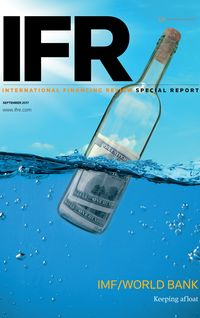Repeated warnings about high and rising global debt levels in emerging markets have so far proved to be false alarms and money continues to flow into assets affording a pick-up to developed markets. Relative value is beguiling, but there is always the risk of volatility in EM markets and always a fear that the market is overdone.
In its global debt monitor of April 2017, the Institute of International Finance highlighted the extent to which EM debt levels had increased. It notes that US$39trn in debt was raised by EM borrowers between 2006 and 2016. Of that, the foreign currency component had more than doubled to US$7.2trn. The phrase ‘EM debt crisis’ was muttered.
“While risks associated with currency mismatches may not be as acute as during past EM debt crises, the overall EM debt burden – particularly as global interest rates head higher – is a growing source of concern,” said the IIF in its report.
It reaffirmed earlier views expressed by the International Monetary Fund that emerging markets are vulnerable to the prospect of rising interest rates in the US due to their corporations ‘being loaded down with debt in both local and foreign currency’.
At the end of 2016, growing EM debt levels, rising US interest rates and a stronger US dollar seemed to be the perfect excuses for fixed income investors to shun EM exposure. It was an understandable conclusion, since in the past, an expanding US economy stoking inflationary pressure and strengthening the currency had been the cue for investors to rush for the EM exit.
“At the beginning of 2017, the outlook for EM was slightly negative,” said Maryam Khosrowshahi, head of CEEMEA sovereign DCM at Deutsche Bank. “There were fears that rate hikes in the US and a stronger dollar would contribute to flows coming out of EM and into other assets.”
But, as the IMF highlighted in a note published in December 2016 as the Fed increased rates for the first time in a year: “Emerging market currencies took a bit of a dive but, overall, investors didn’t overreact and run for the doors with their money.”
Forecasts of an ongoing programme of interest rate rises in the US for 2017, a rapid unwind of the Fed’s balance sheet and a reawakening of dollar strength never really materialised.
“Everything was the opposite,” said Khosrowshahi. “Money continued to flow into the EM on a hard currency basis and, while the Fed did increase rates, other factors have kept long-term yields low. I’d say the outlook for EM for the rest of the year is favourable.”
The path taken by term interest rates during 2017 was a surprise to many.
“Who would have thought that 10-year US Treasury yields would be approaching a 1% handle in September given where the market was at the start of the year?” said Cecile Camilli, head of DCM CEEMEA at Societe Generale.
The yield on the 10-year US Treasury had fallen from its peak of 2.62% in March to one of 2.07% in early September. Over the same period, the dollar had lost over 13% in value against the euro.
Cyclical elements
It is not just a question of what is happening in the US that explains the ongoing attraction for EM. Global economic growth has been on the way back up since the low point of 2015 and EM has improved relative to the developed markets.
“Russia is out of recession and some Central and Eastern European economies are registering GDP growth at levels close to 3%,” said Camilli. “And core Europe’s numbers are now also pointing in the right direction.”
It has given countries the opportunity to address some of the more alarming debt-to-GDP levels of recent years. It brings the headline borrowing numbers into context.
“A concentration on the size of absolute debt levels is an over-simplification of the issue,” said Edwin Gutierrez, head of emerging market sovereign debt at Aberdeen Standard Investments. “There’s no denying that debt levels have been rising over the last 10 years, but great efforts have been made to deleverage since 2010. Corporates and households have been through it, and economic prospects now look much better.”
Countries are generally in better shape from a current account perspective as well. Long gone are the fears for the famous ‘fragile five’ that were prevalent during in 2013 when markets reacted wildly to the ‘taper tantrum’ associated with the Fed cutting back on its quantitative easing programme.
At the time, the likes of Brazil, India, Indonesia, South Africa and Turkey were seen as being particularly vulnerable to tighter monetary conditions in the US due to the size of their current account deficits. Those gaps have largely been addressed and the countries are less vulnerable to renewed tapering in the US or Europe.
Structural changes have also been made over the last decade.
“Lessons have been learned from the experience of previous EM crises when there was a reliance on short-dated US dollars to finance economic growth,” said Gutierrez. “Most countries now rely more heavily on domestic currency for their debt.”
Khosrowshahi agrees. “Domestic capital markets have become more efficient in many countries,” she said. ” Many EM sovereigns rely primarily on domestic markets for funding, with relatively little outstanding debt on the international markets.”
Persistent low interest rates, a weak dollar and improvements in local currency markets would seemingly avert some of the fears regarding the ability to refinance maturing debt – another cause for concern stressed by the IIF. Indeed, the ability to get away some large deals this year confirms the presence of huge pools of liquidity in the market on the lookout for extra yield.
Argentina is a case in point. The serial defaulter’s ability to raise US$2.75bn of debt with its Century bond either confirms the depth of liquidity or, as some suggest, points to a market reaching the top of its cycle.
The likes of Ray Dalio, found of Bridgewater, and DoubleLine Capital’s CEO, Jeffrey Gundlach, clearly feel the latter is true. They advocate adding gold to portfolios and reducing exposure to EM and junk bonds.
Trouble in store
Changes to the way debt has been accumulated over the years could also be storing up problems for the future, with increasing levels of private sector debt in EM – as highlighted by both the IMF and IIF – coming from the Eurobond market.
“The rise in EM debt has been concentrated in the non-financial corporate sector, where debt to GDP has risen from 68% in 2006 to 100% in 2016,” according to the IIF, “though the pace has slowed in recent quarters.”
Rising debt levels in the corporate sector, particularly as a result of Eurobond issuance, may complicate the picture should volatility embrace EM.
“Corporate debt in EM used to be predominantly in the hands of the international banks and, in times of market stress, loans could be rolled over,” said Charles Robertson, global chief economist and head of the macro-strategy unit and Renaissance Capital.
“But as international banks have retreated back to their home markets, corporates have turned to Eurobond issuance to satisfy their borrowing plans. The Eurobond market could freeze in times of turbulence, which may make it more difficult for some firms to refinance.”
He also highlights a shortfall in quality research when it comes to EM corporates.
“EM debt used to be the domain of sovereigns, which were relatively experienced in the markets, and well covered by research analysts,” said Robertson. “That balance has shifted and now there are a lot more borrowers to cover and not necessarily more analysts. The mismatch in analysis is worrying when you consider the number of issuers without the same level of experience in the market being sold into funds without the benefit of the same depth of research.”
There are also signs that, from a credit rating perspective, downside potential for EM credit outweighs prospects for improvement.
“There’s an overall negative bias in the emerging markets of 30% versus a historical average of 20%,” said Diane Vazza, managing director of global fixed income research at S&P Global Ratings. “It suggests that there is a propensity for further downgrades. Conversely, there is limited upside, with the positive bias at 6% against an average of 11%.”
Latam, with a negative bias of 43% against the region’s historical average of 20%, has the greatest potential for additional downgrades, but the numbers are skewed by the dominance of Brazil in that sector. It has a negative bias of 74%.
Problems for EM debt could also stem from the world of commodities, where weak prices jeopardise the current accounts of countries more heavily reliant on natural resources for export receipts.
“A fall in oil or other commodity prices would pose challenges to commodity-based countries,” said Khosrowshahi. “But commodity prices as a whole have been slightly better this year and that’s supportive for the market.”
There is also headline geopolitical risk to take into account, such as North Korea’s repeated missile firing and nuclear warhead testing. But, even then, recent history suggests that the market can withstand the odd hiccup.
“During this year’s strong rally in EM, there’s been very little impact from geopolitical events,” said Camilli. “There’s been an immediate but mild reaction, but the market quickly reverts back to levels seen prior to the event.”
With most of the caveats to investing in EM debt seemingly discounted, the outlook for these markets is benign – at least for the rest of the year and maybe for the next two to three years.
“Potential headwinds from dollar strength and a sell-off in US Treasuries have dissipated and there’s unlikely to be any policy shocks from the Fed or the ECB,” said Gutierrez. “We’re in a good stage of the economic cycle and, while EM is not cheap, it still looks relatively attractive versus developed markets.”
And, as commentators continually stress, with interest rates around the world still at low levels, liquidity will support the hunt for assets that promise just a tad more return.
To see the digital version of this report, please click here.
To purchase printed copies or a PDF of this report, please email gloria.balbastro@tr.com



